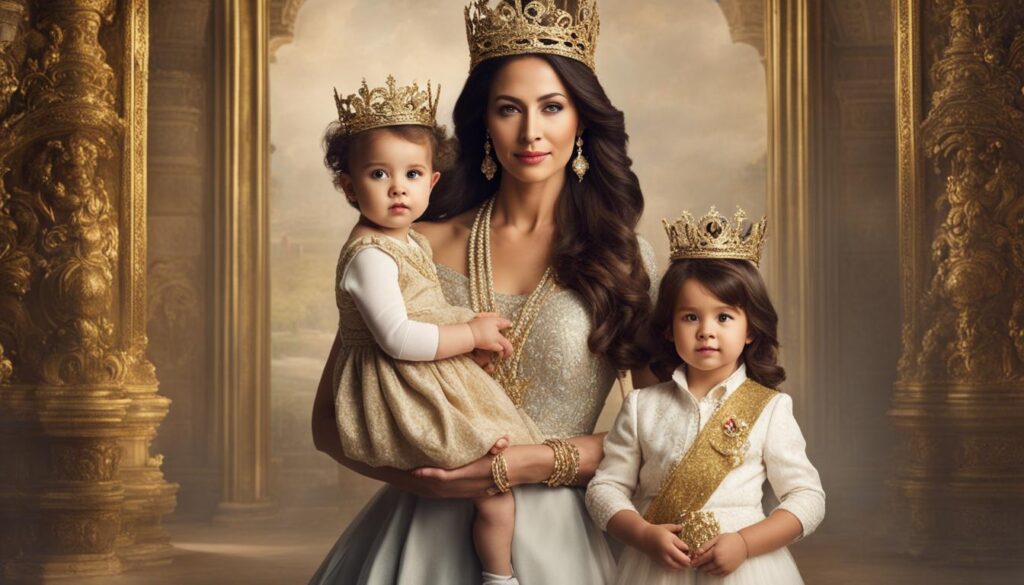What is the son of a princess called?
In royal families, the son of a princess is typically referred to as a prince. This title is the male equivalent of a princess. The specific rules and titles for princes may vary depending on the country and royal family. The son of a princess is often considered a male heir and plays a significant role in the royal lineage and succession.
Key Takeaways:
- The son of a princess is called a prince in royal families.
- Princes are considered male heirs and play a significant role in the royal lineage and succession.
- Specific rules and titles for princes may vary depending on the country and royal family.
Types of Princes
Within the royal family, there are different types of princes who hold various roles and positions. Let’s delve into the distinctions among these princes and explore their significance.
Crown Prince
A crown prince, also known as a crown princess for females, is the designated heir apparent to the throne. This title signifies that they are next in line to assume the role of king or queen after the current monarch’s passing.
Typically, crown princes are the sons of the current king. However, if the king has no children, the position can be filled by a close relative. In some countries, crown princes hold unique titles, such as Prince of Wales or Prince of Asturias.
Let’s take a closer look at the responsibilities and significance of a crown prince in the royal hierarchy.
“The crown prince is a vital figure in the royal family as they are the future ruler and represent the continuity of the monarchy.”
Prince Consort
Another type of prince is known as a prince consort. A prince consort is the husband of a ruling queen, but he does not possess any inherent right to the throne and does not hold the title of king. Rather, he supports and accompanies the queen in her duties and engagements.
Prince Philip, the late husband of Queen Elizabeth II, was an example of a prince consort in the British royal family. Although he was married to the queen, his title remained Prince Philip rather than king.
Sovereign Prince
In certain monarchies, particularly principality states, the title of sovereign prince is used to denote the ruler or head of state. This title is distinct from other types of princes and signifies the highest authority within the principality.
An example of a sovereign prince is Prince Albert II of Monaco, who serves as the head of state for the Principality of Monaco.
These different types of princes play significant roles within the royal family, with each title carrying its own unique symbolism and responsibilities.
| Prince Title | Definition | Example |
|---|---|---|
| Crown Prince | The designated heir apparent to the throne. | Prince Charles, the Prince of Wales |
| Prince Consort | The husband of a ruling queen who does not hold the title of king. | Prince Philip, Duke of Edinburgh |
| Sovereign Prince | The ruler or head of state in principality states. | Prince Albert II of Monaco |
Royal Titles and Succession
Royal titles and succession are integral components of a monarchy, defining the hierarchical structure and the line of succession within the royal family. In this section, I will delve into the significance of royal titles and explore how the son of a princess plays a crucial role as a male heir.
Within a monarchy, the son of a princess is bestowed with the esteemed title of prince, a designation that mirrors the princess’s royal status. This title not only denotes the royal lineage but also establishes the potential for the prince to ascend the throne in the future.
As a male heir, the princess’s son assumes an important position in the line of succession. He becomes part of the lineage that determines who will become the next sovereign ruler. The succession process can vary across different royal families and countries.
“The royal titles and the position of the princess’s son as a male heir exemplify the intricate web of traditions and customs that shape the monarchy.”
In some cases, the title of prince is inherited through the bloodline, directly passed down from the current monarch or his immediate family members. This ensures a smooth transition of power from one generation to the next. Alternatively, the title of prince may also be bestowed upon the son of a monarch or a princess by a reigning monarch, signifying their importance and prominence within the royal family.
It is worth noting that the role of the princess’s son as a male heir extends beyond mere title and succession. Depending on the specific circumstances and traditions of the royal family, the prince may also have specific responsibilities and duties assigned to him.
The Importance of Male Heirs in Royal Succession
The concept of male heirs in royal families stems from historical traditions and beliefs that prioritize male lineage and preserve the continuity of the monarchy. Traditionally, male heirs were considered more suitable for inheriting the throne and carrying forward the family’s dynastic legacy.
However, in recent years, there have been significant changes in many monarchies, with a shift towards gender equality and inclusivity. Several royal families now allow female heirs to ascend the throne, breaking away from the traditional male-preference succession rules.
Despite these progressive changes, the male heir, such as the son of a princess, continues to hold a significant position within the royal family. He represents the continuation of the dynasty and embodies the values and traditions associated with the monarchy.
| Country | Royal Title | Succession Rules |
|---|---|---|
| United Kingdom | Prince of Wales | Eldest son of the reigning monarch |
| Spain | Prince of Asturias | Heir apparent to the Spanish Crown |
| Sweden | Crown Prince | First in line to the Swedish throne |
| Japan | Crown Prince | Eldest son of the Emperor |
This image showcases the grandeur and significance of royal titles and succession within a monarchy, symbolizing the rich history and heritage associated with the royal family.
British Royal Family Titles
In the British royal family, the son of a princess is typically referred to as a prince. After the death of Queen Elizabeth, Prince Charles assumed the role of king and became known as King Charles III. His wife, Camilla, is now styled as Queen Consort, although she may be commonly referred to as Queen Camilla.
It is important to note that the title of King or Queen Consort does not hold the same powers and authority as a reigning monarch. Rather, it signifies the spouse of the reigning monarch and their position within the royal family.
Below is a table showcasing the different titles within the British royal family:
| Title | Role |
|---|---|
| King | The reigning male monarch. |
| Queen Consort | The wife of a reigning king. She does not have the same political power as the king. |
| Prince of Wales | The title given to the heir apparent to the British throne. |
| Duke | A noble title given to members of the royal family. It is often associated with specific regions within the United Kingdom. |
| Duchess | The wife of a duke. |
It is worth mentioning that these titles are subject to change based on the circumstances within the royal family and the lineage of succession.

Prince of Wales
“The Prince of Wales is a title traditionally granted to the heir apparent to the British throne. Currently, Prince Charles holds the title of Prince of Wales.”
Conclusion
In conclusion, the son of a princess is typically bestowed with the royal title of prince in royal families. This title not only signifies their position in the royal lineage but also emphasizes their role as a potential male heir. However, it is important to note that the specific titles and rules for princes may vary depending on the country and the individual royal family.
Within the British royal family, for instance, the son of a princess can eventually ascend to the role of king and may hold various titles throughout their lifetime. As seen with Prince Charles, who assumed the title of King Charles III after the passing of Queen Elizabeth. Furthermore, his wife, Camilla, is now styled as Queen Consort, adding complexity to the hierarchy of royal titles.
The matters of succession and the distribution of royal titles play a crucial role in maintaining the royal lineage and tradition. These decisions not only shape the future of the royal family but also reflect the cultural and historical significance of monarchy. Understanding the intricacies of royal titles and succession is essential in comprehending the structure and the ongoing legacy of royal families.
FAQ
What is the son of a princess called?
The son of a princess is typically referred to as a prince.
What are the types of princes?
There are different types of princes based on their roles and positions within the royal family. These include crown princes, prince consorts, and sovereign princes.
What is the significance of royal titles and succession?
Royal titles and succession are important aspects of the monarchy. They determine the line of succession and the distribution of titles within the royal family.
How does the British royal family’s titles work?
In the British royal family, the son of a princess is typically referred to as a prince. The specific titles and rules for princes may vary depending on the country and royal family.
What is the conclusion about royal titles and succession?
The title of prince is often inherited or bestowed upon the son of a monarch or a princess. The son of a princess, as a prince, holds a significant position in the line of succession and plays a role in the royal lineage.






